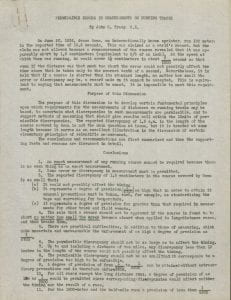The following post was authored by Genevieve Coyle, public services assistant in Manuscripts and Archives.
In 1890, John Clayton Tracy earned his Ph.B from the Sheffield Scientific School at Yale University, and then his Civil Engineer (C.E.) degree from the Yale Graduate School in 1892. He went on to teach in the Department of Civil Engineering at Yale for 46 years, including serving 22 years as the department chairman. Tracy is known to many engineering students for his important work on plane surveying. His 1907 book Plane Surveying: A Textbook and Pocket Manual is still considered by many scholars to be a key piece of work in building today’s knowledge on the topic.
At the very beginning of his extensive time at Yale, Tracy participated in some extracurricular activities, including the 1890 Yale Track Team. While he may not have made a career out of his speed, he was certainly competitive as seen at a track meet on October 26, 1889 where he ran the 100-yard dash in 10.6 seconds. He also served as a judge for several Yale track meets for events including the javelin throw and dashes.
Yet it was his seemingly forgotten role in a track world record that truly merged his two passions for running and civil engineering.
Jesse Owens was a young, Black track runner who had a brief, impressive career in the track world. He is largely known for the four gold medals won at the 1936 Berlin Olympics, and the many world records he held throughout his career. Perhaps most notably, at a May 25, 1935, collegiate track meet at the University of Michigan’s Ferry Field, Owens broke four world records in the timeframe of 45 minutes. Today, Owens is also known as the first man to ever run the 100-meter dash in 10.2 seconds, setting a record that stood until Willie Williams ran it in 10.1 seconds two decades later. Owens held the 100-meter dash world record longer than anyone since.
However, this record was almost never awarded to Owens, through no fault of his own.
On June 20, 1936, Jesse Owens ran 100 meters in 10.2 seconds, which was a tenth of a second faster than the current world record. Unfortunately, a standard post-race measurement of the course found the length to be 1.5 centimeters short. Despite the fact that Owens was clearly on track to still beat the record if he had gone an extra 1.5 centimeters, officials determined this race would not stand as a world record.
Although little record of this incident can be easily found today, Tracy caught wind of the almost world record, and the John Clayton Tracy Papers (MS 502) hold documentation of his attempt to correct the situation. In March 1937, John Tracy wrote to Jesse Owens’ Ohio State University track coach, Larry Snyder, inquiring about how the measurements of the track were performed. Over the next few months, Tracy was brought into the fold of several other individuals all working to prove Owens’ record should be ratified. In addition, the men discussed a broader goal of setting permanent, international measurement standards to prevent these issues in the future. It is worth noting that their discussion includes the effect temperature would have on a steel measuring tape, and today the World Athletics Organization’s current Track and Field Facilities Manual has detailed instructions on exactly how to account for temperature.
As you can see in the May 8, 1937 letter above, Tracy wrote to Paul R. Jordan, chairman of the Records Committee at the Amateur Athletic Union (AAU) of the United States, about the issue. Tracy explains that his expertise on the issue of errors in measurement is two-fold, stemming both from his experience as a judge at track meets as well as his extensive work on plane surveying.
Eventually, on June 11, 1937, John C. Tracy submitted his report, entitled “Permissible Errors in Measurements on Running Tracks,” to the AAU Records Committee. Regrettably, there is no further correspondence on this subject in Tracy’s papers, but we know that Jesse Owens was eventually recognized for having set a new world record that day in 1936.


